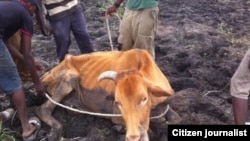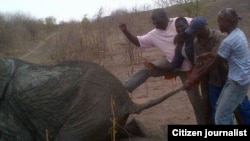WASHINGTON DC —
Communal farmers in Zimbabwe's Matabeleland region say the drought currently ravaging much of the country is reaching alarming proportions and is killing thousands of livestock and wild animals.
Pastures and water sources have dwindled due to poor rainfall, and farmers say they fear for the worst if rains don’t come soon.
Though government sells subsidized stock feed through the Grain Marketing Board (GMB), some villagers in rural areas complain they do not have access to it due to high transport costs.
Photographs shared by one villager in Bambadzi, a community in Plumtree District, Matabeleland South Province, shows villagers frantically trying to extricate cattle stuck in the mud at the drying Mabhongane Dam.
Another photo depicts villagers trying to help a mid-sized elephant to its feet. Villager Difa Dube, who captured the desperate pictures, said the situation is so dire around Bambadzi area that elephants have also started dying.
"We have seen drought in past years, but what is unfolding here could go down in the books of history as one of the worst droughts this part of the country has ever seen," said Dube.
Elephants are particularly vulnerable to drought due to the large volumes of food and water they must consume everyday.
Dube - currently visiting his rural area from Britain where he works - warned that people are also facing the same plight as the dying animals.
He urged government to step up its drought relief efforts to alleviate the situation across the country, particularly in Matabeleland North and South, Masvingo and Midlands - the four provinces hardest hit by drought.
Humanitarian aid organizations have already warned that the drought is likely to cause dangerous shortages of food in the next few months.
The World Food Program (WFP) said in August that over 1.6 million Zimbabweans will require food aid during the peak of the hunger period starting January through March 2013.
Insiza South lawmaker Siyabonga Malandu Ncube told VOA his constituency is also experiencing tough times, but said the government has promised to intervene and ease the situation.
Pastures and water sources have dwindled due to poor rainfall, and farmers say they fear for the worst if rains don’t come soon.
Though government sells subsidized stock feed through the Grain Marketing Board (GMB), some villagers in rural areas complain they do not have access to it due to high transport costs.
Photographs shared by one villager in Bambadzi, a community in Plumtree District, Matabeleland South Province, shows villagers frantically trying to extricate cattle stuck in the mud at the drying Mabhongane Dam.
Another photo depicts villagers trying to help a mid-sized elephant to its feet. Villager Difa Dube, who captured the desperate pictures, said the situation is so dire around Bambadzi area that elephants have also started dying.
"We have seen drought in past years, but what is unfolding here could go down in the books of history as one of the worst droughts this part of the country has ever seen," said Dube.
Elephants are particularly vulnerable to drought due to the large volumes of food and water they must consume everyday.
Dube - currently visiting his rural area from Britain where he works - warned that people are also facing the same plight as the dying animals.
He urged government to step up its drought relief efforts to alleviate the situation across the country, particularly in Matabeleland North and South, Masvingo and Midlands - the four provinces hardest hit by drought.
Humanitarian aid organizations have already warned that the drought is likely to cause dangerous shortages of food in the next few months.
The World Food Program (WFP) said in August that over 1.6 million Zimbabweans will require food aid during the peak of the hunger period starting January through March 2013.
Insiza South lawmaker Siyabonga Malandu Ncube told VOA his constituency is also experiencing tough times, but said the government has promised to intervene and ease the situation.












